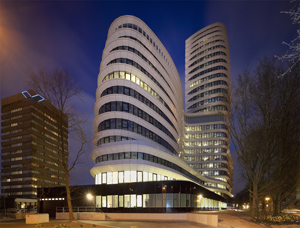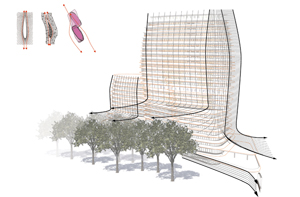 |
 |
 |
 |
 |
 |
| |
 |
|
 |
 |
 |
  |
  |
 |
 |
 |
 |
|
|
 |
|
 |
 |
 |
BUILDING |
 |
|
 |
|
 |
 |
 |
| |
 |
| 
 |
DUO - Dienst Uitvoering Onderwijs en de Belastingdienst
Education Executive Agency and Tax Offices |
|
 |
 |
 |
 |
DESIGNER |
 |
|
|
 |
|
 |
 |
 |
| |
 |
|
 |
 |
 |
 |
DESCRIPTION |
 |
|
|
 |
|
 |
 |
 |
| A greener approach to tall buildings in the post-iconic age - The Education Executive Agency and Tax Offices move to one of Europe’s most sustainable offices |
 |
|
 |
 A new, 92 meter tall complex of soft, undulating curves marks the skyline of Groningen. This asymmetric, aerodynamic construction is set amidst small, ancient woodland, sheltering rare and protected species. The project includes the design, construction and financing of two public institutions; the national tax offices and the student loan administration. The commission from the RGD (National Buildings Service) includes, besides the architecture, the management and building maintenance and care of facilities and services for a period of 20 years. Accommodating 2,500 workstations, parking facilities for 1,500 bicycles and 675 cars in an underground garage, the building will be surrounded by a large public city garden with pond and a multifunctional pavilion with commercial functions. A new, 92 meter tall complex of soft, undulating curves marks the skyline of Groningen. This asymmetric, aerodynamic construction is set amidst small, ancient woodland, sheltering rare and protected species. The project includes the design, construction and financing of two public institutions; the national tax offices and the student loan administration. The commission from the RGD (National Buildings Service) includes, besides the architecture, the management and building maintenance and care of facilities and services for a period of 20 years. Accommodating 2,500 workstations, parking facilities for 1,500 bicycles and 675 cars in an underground garage, the building will be surrounded by a large public city garden with pond and a multifunctional pavilion with commercial functions.
The architecture aims to present these institutions with a softer, more human and approachable profile. Tall buildings are generally associated with mid-twentieth century modernism. Their harsh, businesslike exteriors contain powerful, inaccessible-seeming strongholds. By contrast, the DUO and Tax offices deliberately cloak a commanding public institution in an organic, friendlier and more future-oriented form.
"We paid a great deal of attention to how people would move through the building. The office spaces are designed in such a way that they do not create simple linear corridors leading to dead ends, but instead each corridor has a route which introduces a kind of landscape into the building. You can take endless walks through the building, where there is a great deal of transparency, also towards the surrounding landscape.”
Ben van Berkel |
|
 |
 |
 |
|
 |
|
| Attainability; a mix of affordable and responsible – reaping material benefits of integral design and construction with a Design Build Finance Maintenance Operate contract |
 |
|
 |
 The governmental office complex is built as part of a far-reaching form of public-private partnership (DBFMO) that is designed to effectuate on a more efficient use of public funds. The design, construction, financing, managing and maintenance of the building was hosted by one consortium consisting of Strukton, Ballast Nedam and John Laing. This consortium won the competition for the project on the basis of a combination of esthetic, technical and financial criteria. UNStudio, as the architect of the project, collaborated with Lodewijk Baljon for the landscape design, Arup for the engineering and Studio Linse as the interior advisor. The governmental office complex is built as part of a far-reaching form of public-private partnership (DBFMO) that is designed to effectuate on a more efficient use of public funds. The design, construction, financing, managing and maintenance of the building was hosted by one consortium consisting of Strukton, Ballast Nedam and John Laing. This consortium won the competition for the project on the basis of a combination of esthetic, technical and financial criteria. UNStudio, as the architect of the project, collaborated with Lodewijk Baljon for the landscape design, Arup for the engineering and Studio Linse as the interior advisor.
The life-cycle approach of a DBFMO contract requires that all relevant experts (designers, lawyers, installation specialists, financial specialists, facility specialists) are involved from the start of the project in order to find the best, most cost effective and environmentally-friendly solutions for the continued use and maintenance of the building. This working methodology stimulates not only creative and innovative ideas, but facilitates a reduction of total costs over the entire contract period compared to the traditional means of contracting. In PPP projects contracts are not awarded to the lowest bidder, but to the party with most effective solutions providing the best value for money.
“In a PPP-construction you have to consider all the details concerning maintenance and the sustainable use of the building from the very early stages. It is a unique way to gather all the specialists and the end user around the table from the very outset of the project.”
Ben van Berkel
Edit by UNStudio |
|
 |
 |
 |
|
 |
|
|
|
 |
|
 |
 |
 |
 |
 |
 |
 |
ECO-SUSTAINABILITY |
 |
|
|
 |
|
 |
 |
 |
|
|
 |
 “The design contains numerous new innovations related to the reduction of materials, lower energy costs and more sustainable working environments. It presents a fully integrated, intelligent design approach towards sustainability.” “The design contains numerous new innovations related to the reduction of materials, lower energy costs and more sustainable working environments. It presents a fully integrated, intelligent design approach towards sustainability.”
Ben van Berkel
The project is one of Europe’s most sustainable large new office buildings. The RGD brief prescribed a future-proof building that couples flexibility and sustainability with an esthetic of sobriety. The architectural response to this has been to strive for an all-round understanding of the concept of sustainability, including energy and material consumption, as well as social and environmental factors. Thus the sustainability manifests itself in reduced energy consumption (EPC 0.74), as well as significantly reduced material consumption. Bringing back the floor heights from 3.60 m to 3.30 m resulted in a total reduction of 7.5 m on the entire building, which also lessens the impact of the building on the surroundings. Both inside and outside the architecture generates a bio-climate that is beneficial to both humans and the local flora and fauna.
All-round architectural sustainability: a sum of many parts
Fins
Sustainability and energy reduction have steered the design of the facade, which contains technical installations that are tailored to be durable and cause minimal environmental impact. The facade concept integrates shading, wind control, daylight penetration and construction in fin-shaped elements. These horizontal fins keep a large amount of the heat outside the building, reducing the requirement for cooling.
 Concrete core activation Concrete core activation
Another technical feature of the building that contributes to its sustainable character is the combination of concrete core activation and underground long term energy storage. This appreciably reduces the demand for external energy sources.
Individual climate control for each workspace
Creating a healthy, energy efficient interior climate and employee workspace comfort was also an important element in the design. Plenty of natural daylight and adjustable heating, ventilation and access to fresh air for individual workspaces contribute to the comfort of the workspaces throughout the building.
The 11th floor
A high pressure ventilation system with natural air inflow and outflow via main engineering shafts and the facade grills on the 11th floor reduces the need for artificial ventilation
Future possibilities
In addition, the residual energy of the data center and offices can be used to heat the homes that will be realized in the future in the perimeter of the site.
Flexibility
And last, but not least, the building is designed so that it can be transformed into housing in the future without major structural modifications. Therefore, the locations of elevators, stairs and technical spaces have been carefully considered, and a structural grid of 1.20 m. has been deployed, rather than the conventional office grid of 1.80 m.
Conclusion
The inclusion of diverse passive and active environmental and energy efficient solutions has led to a building which is one of the most sustainable office buildings in the Netherlands.
Edit by UNStudio |
|
 |
 |
 |
 |
 |
 |
 |
LOCATION |
 |
|
|
 |
|
 |
 |
 |

|
 |

|
Continent |
|
 |
|
Nation |
|
 |
|
Region |
|
 |
|
Town |
|
 |
|
Address |
|
 |
|
|
|
 |
|
Website |
|
 |
|
 |
 |
 |
 |
|
TYPOLOGY |
 |
|
|
 |
|
 |
 |
 |
Main |
 |
|
 |
ARCHITECTURE | Buildings for offices and professional practises
Offices
Public buildings
Administration buildings
|
LANDSCAPE ARCHITECTURE AND NATURAL ENVIRONMENTS | Landscape architecture
Public gardens
| |
|
|
 |
|
Additional |
 |
|
 |
ARCHITECTURE | Transport buildings and structures
Garages, car parking, etc.
| |
 |
 |
 |
 |
CHRONOLOGY |
 |
|
|
 |
|
 |
 |
 |
Project |
 |
|
 |
| 
 |
2006
|
|
Realisation |
 |
|
 |
| 
 |
2008 - 2011 |
|
 |
 |
 |
 |
CLIENT |
 |
|
|
 |
|
 |
 |
 |
| |
 |
Consortium DUO² (Strukton, Ballast Nedam, John Laing)
Dutch Government Buildings Agency (RGD) |
|
 |
 |
 |
 |
DIMENSIONAL
DATA |
 |
|
|
 |
|
 |
 |
 |
| Surface |
 |
|
 |
site sq.m. 31,134
offices sq.m. 48,040
parking sq.m. 21,000
pavilion sq.m. 1,500 |
|
| Volume |
 |
|
 |
|
 |
 |
 |
 |
STRUCTURES |
 |
|
|
 |
|
 |
 |
 |
| |
 |
|
 |
 |
 |
 |
LANDSCAPE DESIGN |
 |
|
|
 |
|
 |
 |
 |
| |
 |
|
 |
 |
 |
 |
STAFF |
 |
|
|
 |
|
 |
 |
 |
|
 |
|
Project architect |
 |
| Ben van Berkel, Caroline Bos, Gerard Loozekoot |
|
Design team |
 |
| Jacques van Wijk, Frans van Vuure, Lars Nixdorff and Jesca de Vries, Ramon van der Heijden, Alicja Mielcarek, Eric den Eerzamen, Wendy van der Knijff, Machiel Wafelbakker, Timothy Mitanidis, Maud van Hees, Pablo Herrera Paskevicius, Martijn Prins, Natalie Balini, Peter Moerland, Arjan van der Bliek, Alexander Hugo, Gary Freedman, Jack Chen, Remco de Hoog, Willi van Mulken, Yuri Werner, Machteld Kors, Leon Bloemendaal, Erwin Horstmanshof |
|
Interior design |
 |
|
Graphics and signage |
 |
Buro van Baar (wayfinding)
YNNO (internal logistics) |
|
Acoustical consultant |
 |
|
Fire safety |
 |
|
Structural consultant |
 |
| Ingenieursbureau Wassenaar (prefab structure) |
|
Consultant for energy and environment |
 |
Peutz
WUR (Wageningen University & Research centre) |
|
Construction management |
 |
| Strukton Bouw en Vastgoed |
|
General contractor |
 |
|
 |
  |
 |
|
|